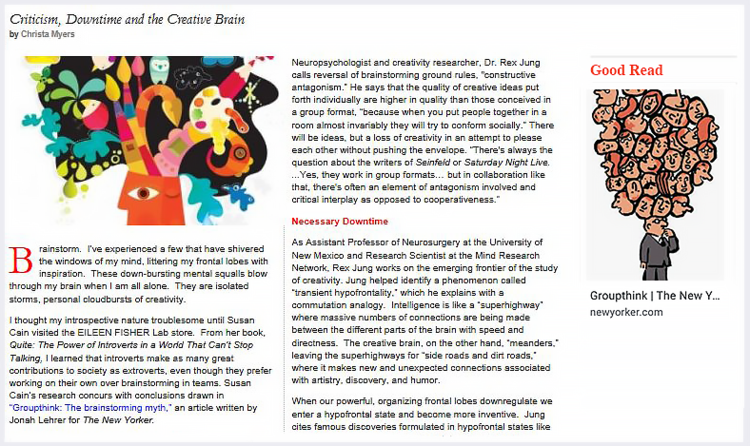
Criticism, Downtime and the Creative Brain
Digital Content
Brainstorm. I’ve experienced a few that have flashed through my mind, flooding my frontal lobes with inspiration. These down-bursting mental squalls are isolated storms, personal cloudbursts of creativity. William Duggan, professor of management at Columbia Business School, calls this type of insight strategic intuition: “shining thoughts that cut through the fog of your mind” in an instant.
Strategic intuition happens in a moment, but it could take weeks for that moment to occur. Often, after laboring over a problem, the best solution comes to me when I least expect it—in the shower, walking down the street, waiting for the train or falling asleep. There’s a reason for this, according to Jonah Lehrer.
In an article for The New Yorker titled “Groupthink: The Brainstorming Myth,” Lehrer states that brainstorming in groups “seems like an ideal technique, a feel-good way to boost productivity. But there is a problem with brainstorming. It doesn’t work.” Numerous studies have come to the same conclusion since the technique was popularized by advertising executive Alex Osborne in 1948. In test after test, brainstorming—creative thinking in groups—didn’t unleash the potential of the group, but rather made each individual less creative.
Critical Interplay
Lehrer explains that the ground rules of brainstorming—no questions, no criticism—as the best way to elicit creativity from a group have proven ineffective. Research shows that groups are more creative, both in quantity and quality of ideas, if they are encouraged to share concepts open to critique. Debating, defending and refining ideas in response to criticism leads to stronger outcomes than uncritical brainstorming.
Neuropsychologist and creativity researcher Dr. Rex Jung calls this reversal of traditional brainstorming rules “constructive antagonism.” He explains that the quality of creative ideas generated individually is often higher than those conceived in group settings because “when you put people together in a room, almost invariably they will try to conform socially. There will be ideas, but a loss of creativity in an attempt to please each other without pushing the envelope.” Jung challenges the notion that famously creative writers’ rooms—like those of Seinfeld or Saturday Night Live—succeed because of group brainstorming. While they do rely on collaboration, he points out that their effectiveness stems from “an element of antagonism involved and critical interplay, as opposed to cooperativeness.”
Necessary Downtime
As an assistant professor of neurosurgery at the University of New Mexico and a research scientist at the Mind Research Network, Dr. Jung works at the forefront of creativity research. He helped identify a phenomenon known as “transient hypofrontality,” which he illustrates with a commuting analogy. Intelligence, he says, is like a superhighway, where information travels rapidly and efficiently between different parts of the brain. The creative brain, by contrast, meanders, “leaving the superhighway for side roads and dirt paths, where it forms new and unexpected connections linked to artistry, discovery, and humor.”
When our powerful, organizing frontal lobes “downregulate,” we enter a “hypofrontal state” and become more inventive. Jung cites famous examples of hypofrontal insight, like Archimedes discovering density in the bath and Kekulé daydreaming about a snake swallowing its tail and conceiving the benzene ring.
Whether we bathe, nap, walk, meditate or exercise, Jung says we can prime our brains to be less directed and more creative. His research suggests that downtime isn’t indulgent; it’s a necessary precondition for original thinking. Encouraging, isn’t it? I think I’ll decelerate, shift my frontal lobes into low gear and let my brain wander down a side road into the eye of a perfect storm.
Branded Content from writing to visual design.
Written and designed to showcase EILEEN FISHER's Wellness Program and company culture, this piece is part of a series exploring health, psychology, and brain science.
- Pre-production: research, brand messaging, content alignment, strategic planning
- Production: writing, copywriting, content creation, graphic design, visual design
- Post-production: web page layout, content + visual alignment, SEO, user engagement
